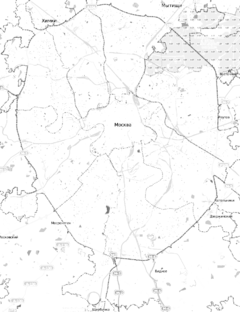Rizhskaya (Moscow Metro)
Rizhskaya (Russian: Рижская) is a Moscow Metro station in the Meshchansky District, North-Eastern Administrative Okrug, Moscow. It is on the Kaluzhsko-Rizhskaya Line, between Prospekt Mira and Alekseyevskaya stations. It is named after the nearby Rizhsky railway station (which was named after and serves trains to the Latvian capital, Riga) and was designed by Latvian architects A. Reinfelds and V. Apsītis. The brightly colored Latvian ceramics employed throughout the station make it instantly recognizable. The pylons, which follow the curve of the station tube, are faced with reddish-brown tile and sandwiched between piers faced with lemon yellow tile and decorated with gold-colored cornices. The ventilation grilles above the pylons are decorated with the coat of arms of the Latvian SSR . The station opened on 1 May 1958.
The round vestibule, which was designed by S.M. Kravets, Yu.A. Kolesnikova, and G.E. Golubev, is located on the east side of Prospekt Mira at Rizhskaya Square.
2004 Terrorist Bombing of Rizhskaya Station
The Rizhskaya station was the site of a terrorist attack by Chechen separatists that occurred shortly after 8 pm on 31 August 2004, in which a bomb was detonated killing 10 people and injuring another 50, some 30 of them seriously.[1] The suicide bombing was thought initially to have been carried out by Roza Nagayeva, but she in fact took part in the Beslan School siege in Ingushetia that started the next day, and was herself killed when the school was stormed several days later.
_(5041543055).jpg)
References
- ↑ Erin E Arvedlund and Sophia Kishkovsky, "After a Spate of Bombings, Moscow's Full of Foreboding", The New York Times Sept. 2, 2004; Arina Borodina, "Terroristicheskaia Sekta," Kommersant" Sept. 2, 2004.


